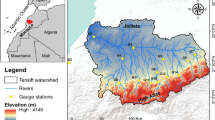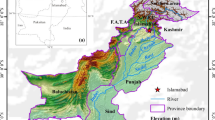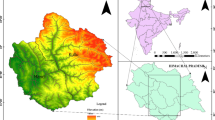Abstract
The intensity-duration (I-D) threshold is considered an effective indicator for landslides triggered by short-term high-intensity rainfall and long-term low-intensity rainfall. However, previous studies have not considered the influence of antecedent rainfall. Herein, we analyzed hourly rainfall data for 613 shallow landslides that occurred from 1963 to 2018 in South Korea to obtain rainfall thresholds and investigated the effect of antecedent rainfall conditions on threshold variations. The I-D and IMAP-D, which is normalized by dividing I by mean annual precipitation (MAP), thresholds were determined to be I = 10.40D–0.31 and IMAP = 0.006D–0.26 (4 ≤ D (h) ≤ 84), respectively, at the 2nd percentile level through quantile regression analysis. These thresholds were lower than other local thresholds (i.e., excluding global and regional thresholds), suggesting that the southern region of the Korean Peninsula was more susceptible to rainfall-induced landslides. Although the effective length of antecedent rainfall was not presented herein, the I-D threshold of landslide-triggering rainfall was confirmed to be low for the absolute and/or calibrated antecedent rainfalls greater than event cumulative rainfall at 5, 7, 10, and 20 days prior to the event. Such differences in I can be greater at shorter durations; however, these differences gradually decrease as D increases, suggesting that they lose their effect as soil water content increases. The results of the current study can improve the understanding of the effect of antecedent rainfall conditions on landslide occurrence and should be further tested with respect to the hydrologic response of hillslopes by considering regional climate and local site conditions.












Similar content being viewed by others
References
Aleotti P (2004) A warning system for rainfall-induced shallow failures. Eng Geol 73:247–265. https://doi.org/10.1016/j.enggeo.2004.01.007
Bacchini M, Zannoni A (2003) Relations between rainfall and triggering of debris-flow: case study of Cancia (Dolomites, Northeastern Italy). Nat Hazards Earth Syst Sci 3:71–79. https://doi.org/10.5194/nhess-3-71-2003
Baum RL, Godt JW, Savage WZ (2010) Estimating the timing and location of shallow rainfall-induced landslides using a model for transient, unsaturated infiltration. J Geophys Res 115:F03013. https://doi.org/10.1029/2009JF001321
Brand EW (1981) Some thoughts on rainfall-induced slope failures. Proceedings of 10th International Conference on Soil Mechanics and Foundation Engineering. Balkema, Rotterdam, pp 373–376
Brand EW, Premchitt J, Phillipson HB (1984) Relationship between rainfall and landslides in Hong Kong. Proceedings of 4th International Symposium on Landslides. Toronto, pp 377–384
Brunetti MT, Peruccacci S, Rossi M, Luciani S, Valigi D, Guzzetti F (2010) Rainfall thresholds for the possible occurrence of landslides in Italy. Nat Hazards Earth Syst Sci 10:447–458. https://doi.org/10.5194/nhess-10-447-2010
Caine N (1980) The rainfall intensity-duration control of shallow landslides and debris flows. Geogr Ann A 62:23–27
Campbell RH (1975) Soil slips, debris flows, and rainstorms in the Santa Monica Mountains and vicinity, southern California. US Geological Survey Professional Paper 851. Washington DC, US Government Printing Office, 51 p
Cannon S, Gartner J, Wilson R, Bowers J, Laber J (2008) Storm rainfall conditions for floods and debris flows from recently burned areas in southwestern Colorado and southern California. Geomorphology 96:250–269. https://doi.org/10.1016/j.geomorph.2007.03.019
Canuti P, Focardi P, Garzonio CA (1985) Correlation between rainfall and landslides. Bull Int Assoc Eng Geol 32:49–54
Capecchi F, Focardi P (1988) Rainfall and landslides: research into a critical precipitation coefficient in an area of Italy. In: Bonnard C (ed) Landslides, Proceedings of the 5th International Symposium on Landslides. Balkema, Roterdam, pp 1131–1136
Chae BG, Kim MI (2012) Suggestion of a method for landslide early warning using the change in the volumetric water content gradient due to rainfall infiltration. Environ Earth Sci 66(7):1973–1986. https://doi.org/10.1007/s12665-011-1423-z
Chen CY, Chen TC, Yu FC, Yu WH, Tseng CC (2005) Rainfall duration and debris-flow initiated studies for real-time monitoring. Environ Geol 47:715–724. https://doi.org/10.1007/s00254-004-1203-0
Chen CW, Saito H, Oguchi T (2015) Rainfall intensity-duration conditions for mass movements in Taiwan. Prog Earth Planet Sci 2:1–13. https://doi.org/10.1186/s40645-015-0049-2
Choi K (1986) Landslides occurrence and its prediction in Korea. Kangwon National University, Ph. D. Dissertation (in Korean with English abstract)
Crosta G (1998) Regionalization of rainfall thresholds: an aid to landslide hazard evaluation. Environ Geol 35:131–145. https://doi.org/10.1007/s002540050300
Crosta GB, Frattini P (2001) Rainfall thresholds for triggering soil slips and debris flow. In: Mugnai A, Guzzetti F, Roth G (eds) Mediterranean storms. Proceedings of the 2nd EGS Plinius Conference on Mediterranean Storms. Siena, Italy, pp 463–487
Crosta GB, Frattini P (2003) Distributed modeling of shallow landslides triggered by intense rainfall. Nat Hazards Earth Syst Sci 3:81–93. https://doi.org/10.5194/nhess-3-81-2003
Crozier MJ (1989) Landslides: Causes, Consequences and Environment. Routledge, London
Crozier MJ (1999) Prediction of rainfall-triggered landslides: a test of the antecedent water status model. Earth Surf Process Landf 24:825–833
Crozier MJ, Eyles RJ (1980) Assessing the probability of rapid mass movement. In: The New Zealand Institution of Engineers. Proceedings 3rd Australia New Zealand Conference on Geomechanics, New Zealand. Inst Eng Proc Techn Groups 6:2.47–2.51
Crozier MJ, Glade T (1999) Frequency and magnitude of landsliding: fundamental research issues. Z Geomorph NF Suppl 115:141–155
Dahal RK, Hasegawa S (2008) Representative rainfall thresholds for landslides in the Nepal Himalaya. Geomorphology 100:429–443. https://doi.org/10.1016/j.geomorph.2008.01.014
Giannecchini R, Galanti Y, D'Amato Avanzi G (2012) Critical rainfall thresholds for triggering shallow landslides in the Serchio River valley (Tuscany, Italy). Nat Hazards Earth Syst Sci 12:829–842. https://doi.org/10.5194/nhess-12-829-2012
Glade T, Crozier MJ (2005) The nature of landslide hazard impact. In: Glade T, Anderson MG, Crozier MJ (eds) Landslide Hazard and Risk. Wiley, Chichester, pp 43–74
Glade T, Crozier MJ, Smith P (2000) Applying probability determination to refine landslide-triggering rainfall thresholds using an empirical “Antecedent Daily Rainfall Model”. Pure Appl Geophys 157:1059–1079. https://doi.org/10.1007/s000240050017
Guzzetti F, Peruccacci S, Rossi M, Stark CP (2007) Rainfall thresholds for the initiation of landslides in central and southern Europe. Meteorog Atmos Phys 98:239–267. https://doi.org/10.1007/s00703-007-0262-7
Guzzetti F, Peruccacci S, Rossi M, Stark CP (2008) The rainfall intensity-duration control of shallow landslides and debris flows: an update. Landslides 5:3–17. https://doi.org/10.1007/s10346-007-0112-1
Hasnawir, Kubota T (2008) Analysis of critical value of rainfall to induce landslides and debris-flow in Mt. Bawakaraeng Caldera, South Sulawesi, Indonesia. J Fac Agric Kyushu Univ 53:523–527
Hong WP, Kim SK, Kim M, Kim YW, Han JG (1990) Prediction of rainfall-triggered landslides in Korea. J Korean Geotech Soc 6:55–63 (in Korean with English abstract)
Hong Y, Hiura H, Shino K, Sassa K, Suemine A, Fukuoka H, Wang G (2005) The influence of intense rainfall on the activity of large-scale crystalline schist landslides in Shikoku Island, Japan. Landslides 2:97–105. https://doi.org/10.1007/s10346-004-0043-z
Hwang ES, Chung DS, Kim KS, Lee MS, Song YS (2013) Characteristics analysis of mudstone weathered soils in the landslide area using statistical technique. J Korean Geosynthetics Soc 12:31–41 (in Korean with English abstract)
Jakob M, Weatherly H (2003) A hydroclimatic threshold for landslide initiation on the north Shore Mountains of Vancouver, British Columbia. Geomorphology 54:137–156. https://doi.org/10.1016/S0169-555X(02)00339-2
Jau JG, Park SJ, Son DS, Joo SH (2000) The effects of geological and topographical features on landslide and land-creep. J Korean For Soc 89:323–334 (in Korean with English abstract)
Jibson RW (1989) Debris flows in southern Puerto Rico. Geological Society of America Special Paper 236:29–55. Cited by Guzzetti et al. (2007)
Keefer DK, Wilson RC, Mark RK, Brabb EE, Brown WM, Ellen SD, Harp EL, Wieczorek GF, Alger CS, Zatkin RS (1987) Real-time landslide warning during heavy rainfall. Science 238:921–925. https://doi.org/10.1126/science.238.4829.921
Khan YA, Lateh H, Baten MA, Kamil AA (2012) Critical antecedent rainfall conditions for shallow landslides in Chittagong City of Bangladesh. Environ Earth Sci 67:97–106. https://doi.org/10.1007/s12665-011-1483-0
Kim KS (2019) Soil properties of granitic weathered soils in the landslide-prone areas in Seoul. Kor J Eng Geol 29:23–35. (in Korean with English abstract). https://doi.org/10.9720/kseg.2019.1.023
Kim WY, Chae BG (2009) Characteristics of rainfall, geology and failure geometry of the landslide areas on natural terrains, Korea. Kor J Eng Geol 19:331–344 (in Korean with English abstract)
Kim SK, Hong WP, Kim YM (1991) Prediction of rainfall-triggered landslides in Korea. In: Bell DH (ed) Landslides, Proceedings of the 6th International Symposium on Landslides, vol 2. Balkema, Rotterdam, pp 989–994
Kim SW, Chun KW, Kim MS, Kim MS, Kim JH, Lee DK (2013a) Rainfall intensity-duration thresholds for the initiation of a shallow landslide in South Korea. Jour Korean For Soc 102:463–466 (in Korean with English abstract)
Kim JH, Jeong SS, Kim YM, Lee KW (2013b) Proposal of design method for landslides considering antecedent rainfall and in-situ matric suction. J Korean Geotech Soc 29:11–24. (in Korean with English abstract). https://doi.org/10.7843/kgs.2013.29.12.11
Kim SW, Chun KW, Otsuki K, Shinohara Y, Kim MI, Kim MS, Lee DK, Seo JI, Choi B (2015) Heavy rain types for triggering shallow landslides in South Korea. J Fac Agric Kyushu Univ 60:243–249
Koenker R (2005) Quantile regression. Cambridge University Press, New York
Koenker RW (2009) Quantile regression in R: a vignette. http://www.cran.r-project.org/web/packages/quantreg/vignettes/rq.pdf
Korea Meteorological Administration (1991) Climatological normals of Korea (1961–1990). Korea Meteorological Administration, Seoul (in Korean)
Korea Meteorological Administration (2001) Climatological normals of Korea (1971–2000). Korea Meteorological Administration, Seoul (in Korean)
Korea Meteorological Administration (2011) Changma white book. Korea Meteorological Administration, Seoul (in Korean)
Korea Meteorological Administration (2012) The climate atlas of Korea. Korea Meteorological Administration, Seoul (in Korean)
Korea Research Institute for Human Settlements (2008) Policy measurement for the efficient management of forest land (Korea Forest Service Res Rep). Korea Forest Service, Daejeon (in Korean)
Larsen M, Simon A (1993) A rainfall intensity–duration threshold for landslides in a humid-tropical environment: Puerto Rico. Geogr Ann A 75:13–23
Lee JS, Song YK, Kim YT (2012) Slope stability characteristic of unsaturated weathered granite soil in Inje considering antecedent rainfall. J Korean Soc Hazard Mitig 12:85–92 (in Korean with English abstract)
Lumb P (1975) Slope failures in Hong-Kong. Q J Eng Geol 8:31–65. https://doi.org/10.1144/GSL.QJEG.1975.008.01.02
Marques R, Zêzere J, Trigo R, Gaspar J, Trigo I (2008) Rainfall patterns and critical values associated with landslides in Povoação County (São Miguel Island, Azores): relationship with the North Atlantic Oscillation. Hydrol Process 22:478–494. https://doi.org/10.1002/hyp.6879
Martelloni G, Segoni S, Fanti R, Catani F (2012) Rainfall thresholds for the forecasting of landslide occurrence at regional scale. Landslides 9:485–495. https://doi.org/10.1007/s10346-011-0308-2
Mathew J, Babu DG, Kundu S, Kumar KV, Pant CC (2014) Integrating intensity-duration-based rainfall threshold and antecedent rainfall-based probability estimate towards generating early warning for rainfall-induced landslides in parts of the Garhwal Himalaya, India. Landslides 11:575–588. https://doi.org/10.1007/s10346-013-0408-2
Ministry of Land, Infrastructure and Transport (2004) Development of warning and evacuation system sediment disaster in developing countries. Ministry of Land, Infrastructure and Transport, Tokyo
Montgomery DR, Dietrich WE (1994) A physically-based model for the topographic control on shallow landsliding. Water Resour Res 30:1153–1171. https://doi.org/10.1029/93WR02979
National Geographic Information Institute (2010) The geography of Korea. National Geographic Information Institute, Gyeonggi-do
National Geographic Information Institute (2016) The National Atlas of Korea II. National Geographic Information Institute, Gyeonggi-do
National Institute for Disaster Prevention (2003) 2002 Disaster white book. National Institute for Disaster Prevention. Ministry of Government Administration and Home Affairs, Seoul (in Korean)
National Institute for Disaster Prevention (2005) A study on the monitoring and detection of slope failure (II): focusing on the application of rainfall data. National Institute for Disaster Prevention. Ministry of Government Administration and Home Affairs, Seoul (in Korean)
Park C, Moon JY, Cha EJ, Yun WT, Choi Y (2008) Recent changes in summer precipitation characteristics over South Korea. J Korean Geogr Soc 43:324–336 (in Korean with English abstract)
Park JY, Lee SR, Lee DH, Kim YT, Oh S, Park HJ (2018) Development of continuous rainfall-based citywide landslide early warning model. J Korean Soc Hazard Mitig 18:99–111 (in Korean with English abstract)
Pasuto A, Silvano S (1998) Rainfall as a triggering factor of shallow mass movements. A case study in the dolomites, Italy. Environ Geol 35:184–189. https://doi.org/10.1007/s002540050304
Peres DJ, Cancelliere A (2014) Derivation and evaluation of landslide-triggering thresholds by a Monte Carlo approach. Hydrol Earth Syst Sci 18:4913–4931. https://doi.org/10.5194/hess-18-4913-2014
Rahardjo H, Li XW, Toll DG, Leong EC (2001) The effect of antecedent rainfall on slope stability. Geotech Geol Eng 19:371–399. https://doi.org/10.1023/A:1013129725263
Rahardjo H, Leong EC, Rezaur RB (2008) Effect of antecedent rainfall on pore-water pressure distribution characteristics in residual soil slopes under tropical rainfall. Hydrol Process 22:506–523. https://doi.org/10.1002/hyp.6880
Rahimi A, Rahardjo H, Leong EC (2011) Effect of antecedent rainfall patterns on rainfall-induced slope failure. J Geotech Geoenviron 137:483–491
Rosi A, Segoni S, Catani F, Casagli N (2012) Statistical and environmental analyses for the definition of a regional rainfall threshold system for landslide triggering in Tuscany (Italy). J Geogr Sci 22:617–629. https://doi.org/10.1007/s11442-012-0951-0
Saito H, Matsuyama H (2012) Catastrophic landslide disasters triggered by record-breaking rainfall in Japan: their accurate detection with normalized soil water index in the Kii peninsula for the year 2011. SOLA 8:81–84. https://doi.org/10.2151/sola.2012-021
Saito H, Nakayama D, Matsuyama H (2010) Relationship between the initiation of a shallow landslide and rainfall intensity-duration thresholds in Japan. Geomorphology 118:167–175. https://doi.org/10.1016/j.geomorph.2009.12.016
Segoni S, Rosi A, Rossi G, Catani F, Casagli N (2014) Analysing the relationship between rainfalls and landslides to define a mosaic of triggering thresholds for regional-scale warning systems. Nat Hazards Earth Syst Sci 14:2637–2648. https://doi.org/10.5194/nhess-14-2637-2014
Segoni S, Battistini A, Rossi G, Rosi A, Lagomarsino D, Catani F, Moretti S, Casagli N (2015) Technical note: an operational landslide early warning system at regional scale based on space–time-variable rainfall thresholds. Nat Hazards Earth Syst Sci 15:853–861. https://doi.org/10.5194/nhess-15-853-2015
Seo HS, Han SG (2003) A study on the characteristics of landslides having occurred in Gangneung area in 2002. J Korean Geotech Soc 19:107–119 (in Korean with English abstract)
Sidle RC (1992) A theoretical model of the effects of timber harvesting on slope stability. Water Resour Res 28:1897–1910. https://doi.org/10.1029/92WR00804
Sidle RC, Ochiai H (2006) Landslides: processes, prediction, and land use. American Geophysical Union, Washington DC
Terlien MTJ (1998) The determination of statistical and deterministic hydrological landslide-triggering thresholds. Environ Geol 35:124–130. https://doi.org/10.1007/s002540050299
Wasowski J (1998) Understanding rainfall-landslide relationships in man-modified environments: a case-history from Caramanico Terme, Italy. Environ Geol 35:197–209. https://doi.org/10.1007/s002540050306
Wieczorek GF (1996) Landslide triggering mechanisms. In: Turner AK, Schuster RL (eds) Landslides: investigation and mitigation. Transportation Research Board, National Research Council, Washington DC, pp. 76–90
Wieczorek GF, Glade T (2005) Climatic factors influencing occurrence of debris flows. In: Jakob M, Hungr O (eds) Debris-flow hazards and related phenomena. Springer, Berlin Heidelberg, pp 325–362
World Meteorological Organization (2007) The role of climatological normal in a changing climate. WMO-TD No 1377
Wu W, Sidle RC (1995) A distributed slope stability model for steep forested basins. Water Resour Res 31:2097–2110. https://doi.org/10.1029/95WR01136
Yoo N, Yoon D, Um J, Kim D, Park B (2012) Anaysis of rainfall characteristics and landslides at the west side area of Gangwon Province. J Korea Geo-environ Soc 13:75–82 (in Korean with English abstract)
Acknowledgements
The authors would like to thank the anonymous reviewers for their critical and useful comments. This research was supported by Korea Ministry of Environment as “The SS (Surface Soil conservation and management) projects; 2019002830002”. In addition, this research was conducted in part with the support of “R&D Program for Forest Science Technology (Project No. 2017061B10-1919-AB01)” provided by Korea Forest Service (Korea Forestry Promotion Institute).
Author information
Authors and Affiliations
Corresponding authors
Rights and permissions
About this article
Cite this article
Kim, S.W., Chun, K.W., Kim, M. et al. Effect of antecedent rainfall conditions and their variations on shallow landslide-triggering rainfall thresholds in South Korea. Landslides 18, 569–582 (2021). https://doi.org/10.1007/s10346-020-01505-4
Received:
Accepted:
Published:
Issue Date:
DOI: https://doi.org/10.1007/s10346-020-01505-4




